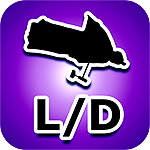
The Wingsuit Theory, or How to fly like an eagle while barely moving on the couch
By
yuri_base, in Wing Suit Flying
Recommended Posts
KrisFlyZ 0
Your post confuses AoA and pitch.
In the last sentence do you mean pitch or AoA? Because headdown and flat from start refer to pitch.
What equations did you use and what ax and ay did you use? Because these are non zero.
Are you talking about 45 degree AoA? Because at zero velocity 45 degree AoA = what pitch and what L/D?
The graphs are more than a bit off in regards to real world observations.
Take a look at Terje's exit in this movie. The flight starts way before 200'(if that of fall) and I cannot tell if the AoA is 45 degrees.
By the time a wingsuit flyer falls 300m, well over 1:1 GR can be reached.
You have seen James's bridge day video? Depending on opening altitude, that final GR is probably over 1:1 at that point and the altitude lost is not even 600'?
Kris.
Quote45 degree technique wins hands down. Due to its high lift coefficient, it propels you forward much more efficiently than even the best L/D AoA. Below 1000ft down, best L/D catches up and soon beats the 45 degree. At these altitudes, the glide ratio is already 1.0 and increasing, so it's time to switch from 45 degrees to full maxed out flight.
The headdown and "flat from the start" techniques are the least efficient.
In the last sentence do you mean pitch or AoA? Because headdown and flat from start refer to pitch.
What equations did you use and what ax and ay did you use? Because these are non zero.
Are you talking about 45 degree AoA? Because at zero velocity 45 degree AoA = what pitch and what L/D?
The graphs are more than a bit off in regards to real world observations.
Take a look at Terje's exit in this movie. The flight starts way before 200'(if that of fall) and I cannot tell if the AoA is 45 degrees.
By the time a wingsuit flyer falls 300m, well over 1:1 GR can be reached.
You have seen James's bridge day video? Depending on opening altitude, that final GR is probably over 1:1 at that point and the altitude lost is not even 600'?
Kris.
mccordia 74
Quote
If they feel this , they are not holding proper position for maxing out in terms of either FF time nor distance!
Proper arm position maybe the reason?
Several people flying V1/V2s complained about it around here, thats why I asked...
Ive seen people use some really akward arm and body positions trying to fly their suits. We're always trying to assist in heloing them see what they could change to improve flying wise. So any tips on this subject would be great..
We noticed that in your video's, the arm wing is always perfect. One smooth shape.
While with a lot of flyers, there is a clear line. Cut across the wing. like a fold. Is that whats causing their armwing to be 'heavy to fly'?
And maybe also tipping them headlow a bit to much (having trouble staying up with slower formations)
Its seen a little in this picture
But its more pronounced with some of the people I've seen.
Does it require more pushing down on the wing, or pulling grippers outward to create a smooth wingshape there?
It would be great of (body position-wise) you'd have some tips and pointers on that subject?
JC
FlyLikeBrick
I'm an Athlete?
FlyLikeBrick
I'm an Athlete?



Share this post
Link to post
Share on other sites